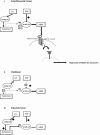Clinical Utility of Anti-Mullerian Hormone in Pediatrics
- PMID: 34537849
- PMCID: PMC8764360
- DOI: 10.1210/clinem/dgab687
Clinical Utility of Anti-Mullerian Hormone in Pediatrics
Abstract
Context: Anti-Mullerian hormone (AMH) was originally described in the context of sexual differentiation in the male fetus but has gained prominence now as a marker of ovarian reserve and fertility in females. In this mini-review, we offer an updated synopsis on AMH and its clinical utility in pediatric patients.
Design and results: A systematic search was undertaken for studies related to the physiology of AMH, normative data, and clinical role in pediatrics. In males, AMH, secreted by Sertoli cells, is found at high levels prenatally and throughout childhood and declines with progression through puberty to overlap with levels in females. Thus, serum AMH has clinical utility as a marker of testicular tissue in males with differences in sexual development and cryptorchidism and in the evaluation of persistent Mullerian duct syndrome. In females, serum AMH has been used as a predictive marker of ovarian reserve and fertility, but prepubertal and adolescent AMH assessments need to be interpreted cautiously. AMH is also a marker of tumor burden, progression, and recurrence in germ cell tumors of the ovary.
Conclusions: AMH has widespread clinical diagnostic utility in pediatrics but interpretation is often challenging and should be undertaken in the context of not only age and sex but also developmental and pubertal stage of the child. Nonstandardized assays necessitate the need for assay-specific normative data. The recognition of the role of AMH beyond gonadal development and maturation may usher in novel diagnostic and therapeutic applications that would further expand its utility in pediatric care.
Keywords: AMH; DSD; MIS; fertility; pediatrics.
© The Author(s) 2021. Published by Oxford University Press on behalf of the Endocrine Society.
Figures



Similar articles
-
Anti-Mullerian Hormone (AMH) Determinations in the Pediatric and Adolescent Endocrine Practice.Pediatr Endocrinol Rev. 2017 Jun;14(4):364-370. doi: 10.17458/per.vol14.2017.WG.Mullerian. Pediatr Endocrinol Rev. 2017. PMID: 28613046 Review.
-
Anti-Müllerian hormone profiling in prepubertal horses and its relationship with gonadal function.Theriogenology. 2018 Sep 1;117:72-77. doi: 10.1016/j.theriogenology.2018.05.012. Epub 2018 May 15. Theriogenology. 2018. PMID: 29784463
-
Anti-Müllerian hormone: a unique biochemical marker of gonadal development and fertility in humans.Biochem Med (Zagreb). 2011;21(3):219-30. doi: 10.11613/bm.2011.031. Biochem Med (Zagreb). 2011. PMID: 22420235 Review.
-
Anti-Müllerian hormone levels in girls and adolescents with Turner syndrome are related to karyotype, pubertal development and growth hormone treatment.Hum Reprod. 2013 Jul;28(7):1899-907. doi: 10.1093/humrep/det089. Epub 2013 Mar 28. Hum Reprod. 2013. PMID: 23539612
-
MIS/AMH in the assessment of cryptorchidism and intersex conditions.Mol Cell Endocrinol. 2003 Dec 15;211(1-2):91-8. doi: 10.1016/j.mce.2003.09.014. Mol Cell Endocrinol. 2003. PMID: 14656481 Review.
Cited by
-
Clinical utility of anti-Müllerian hormone in female children and adolescents.Hormones (Athens). 2024 Oct 31. doi: 10.1007/s42000-024-00603-5. Online ahead of print. Hormones (Athens). 2024. PMID: 39477856 Review.
-
Anti-Müllerian hormone, testicular descent and cryptorchidism.Front Endocrinol (Lausanne). 2024 Mar 4;15:1361032. doi: 10.3389/fendo.2024.1361032. eCollection 2024. Front Endocrinol (Lausanne). 2024. PMID: 38501100 Free PMC article. Review.
-
Anti-Müllerian hormone beyond an ovarian reserve marker: the relationship with the physiology and pathology in the life-long follicle development.Front Endocrinol (Lausanne). 2023 Nov 3;14:1273966. doi: 10.3389/fendo.2023.1273966. eCollection 2023. Front Endocrinol (Lausanne). 2023. PMID: 38027144 Free PMC article. Review.
-
Paediatric Wolfram syndrome Type 1: should gonadal dysfunction be part of the diagnostic criteria?Front Endocrinol (Lausanne). 2023 Jun 13;14:1155644. doi: 10.3389/fendo.2023.1155644. eCollection 2023. Front Endocrinol (Lausanne). 2023. PMID: 37383390 Free PMC article.
-
The Stability of the Anti-Müllerian Hormone in Serum and Plasma Samples under Various Preanalytical Conditions.Diagnostics (Basel). 2023 Apr 21;13(8):1501. doi: 10.3390/diagnostics13081501. Diagnostics (Basel). 2023. PMID: 37189609 Free PMC article.
References
-
- Teixeira J, Maheswaran S, Donahoe PK. Müllerian inhibiting substance: an instructive developmental hormone with diagnostic and possible therapeutic applications. Endocr Rev. 2001;22(5):657-674. - PubMed
-
- Jost A. Problems of fetal endocrinology: the gonadal and hypophyseal hormones. Recent Progr Horm Res. 1953;8:379-413.
-
- Josso N. In vitro synthesis of Müllerian-inhibiting hormone by seminiferous tubules isolated from the calf fetal testis. Endocrinology. 1973;93(4):829-834. - PubMed
-
- Ragin RC, Donahoe PK, Kenneally MK, Ahmad MF, MacLaughlin DT. Human Müllerian inhibiting substance: enhanced purification imparts biochemical stability and restores antiproliferative effects. Protein Expr Purif. 1992;3(3):236-245. - PubMed

